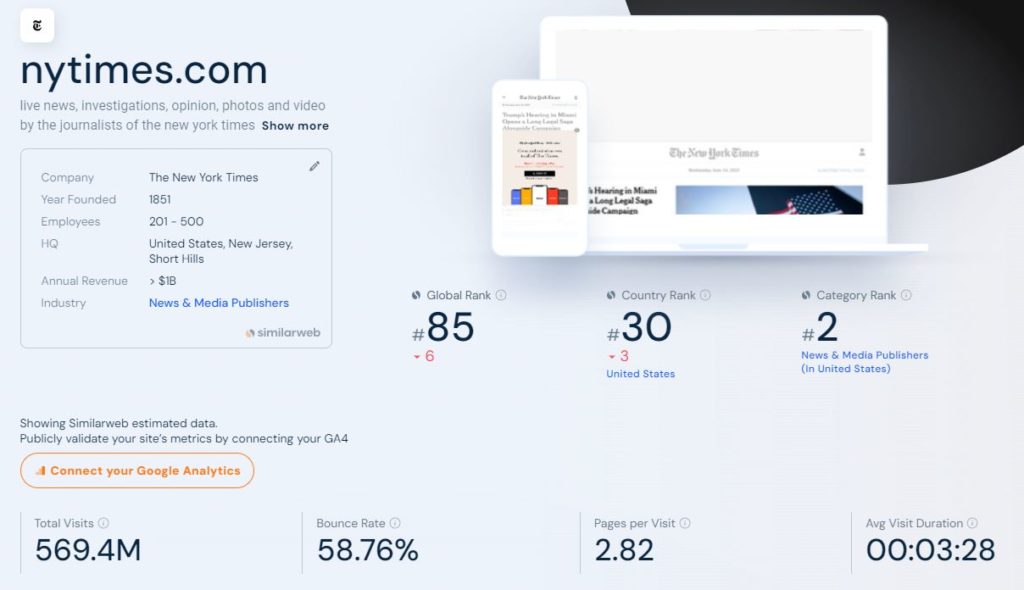In This Guide:
- Background on The New York Times and how their reputation can help boost your press release or news tip.
- Instructions on how to professionally contact The New York Times with your press release or news tip.
- An overview of the submission process and how to increase the likelihood of securing a backlink to your site.
- How platforms like AmpiFire can help you distribute your press release to The New York Times.

The New York Times Press Release vs. Submitting a News Story Tip
We all know The New York Times (NYT) as one of the world’s leading news organizations. Established in 1851, it’s consistently been at the forefront of journalism, known for its high-quality reporting and trustworthy content. With an impressive online readership of over 150 million monthly unique visitors, it stands as a robust platform for communication. Most importantly, it targets a diverse audience, ranging from policymakers and business leaders to scholars and general news enthusiasts.

So, why am I telling you all this? Because if you’re aiming to send out a press release or a news story tip, the distinction between the two on such a platform matters. But what’s the difference between submitting a press release and a news story tip to the NYT?
Press Release vs. News Story Tip
Press Release:
- An official statement or announcement about significant events, product launches, or other happenings.
- Packaged for easy media consumption with the hope of publications like The New York Times sharing it.
News Story Tip:
- An insider scoop or lead on a potential story, not necessarily fully developed.
- Raw material for journalists, like tips on unannounced events or whistleblowers revealing information.
Therefore, when you’re trying to get your news onto the NYT platform, you need to decide whether you’re presenting a polished announcement (press release) or providing them with a hot lead (news story tip).
In conclusion, understanding the difference between a press release and a news story tip, and knowing the kind of audience The New York Times attracts, is crucial in effectively using this platform to your advantage. Choose wisely and craft your submissions accordingly!
How to Contact The New York Times to Feature Your Story
Getting news sites like The New York Times, Bloomberg, or CNBC to notice you starts with an effective introduction. Therefore, whether you’re an individual with a hot tip or a PR representative of a company, presenting yourself professionally is crucial.
Contact Information for The New York Times
Below is a partial list of journalists that work at The New York Times:
- Sapna Maheshwari – Business Reporter
- Cade Metz – Reporter
- LinkedIn: https://www.linkedin.com/in/cademetz/
- Sharon Otterman – Metro Reporter
- Mihir Zaveri – Reporter
While this list can serve as a jumping-off point for your own research, it’s important to remember there are many other potential contacts at The New York Times. It’s important to determine the best point of contact for your individual needs. The New York Times also has several email address to submit your press release to, organized by department.
- Business – bizday@nytimes.com
- Editorial – editorial@nytimes.com
- Foreign – foreign@nytimes.com
- Letter to the Editor – letters@nytimes.com
- Metro – metro@nytimes.com
- Sports – sports@nytimes.com
- Washington – washington@nytimes.com
- National – national@nytimes.com
- Arts & Culture – thearts@nytimes.com
- Sunday Metropolitan – metropolitan@nytimes.com
If you’d like to submit a confidential tip, you can reach out to The New York Times here.
For general inquiries, you can use The New York Times contact page here.
Remember, The New York Times is an institution with a rich legacy. Approaching them requires tact, respect, and patience. Most importantly, make sure your story has substance. The right story, presented the right way, can indeed find its place in their esteemed columns.
How to Submit a Press Release & Publish Directly on The New York Times
The New York Times isn’t just any news platform; it’s a globally recognized institution. Making your way onto its esteemed pages can significantly amplify your message, granting it unparalleled reach and credibility.
The Process: Getting Your Press Release onto The New York Times
- Choose the Right Category: Before anything else, ensure you choose the right department or category for your press release. The New York Times has several sections, and directing your press release to the appropriate one increases its chances of being noticed.
- Craft a Compelling Headline: Capture attention immediately. Your headline should be engaging, relevant, and give a quick snapshot of your press release’s content.
- Maintain a Professional Tone: This isn’t the place for slang or overly casual language. Keep your content polished, accurate, and adhere to journalistic standards.
- Use Multimedia: Including relevant images, infographics, or short videos can make your press release stand out. However, ensure they’re high quality and complement your content.
- Contact the Right People: Instead of sending your press release into the void, target specific editors or journalists known for covering your press release’s topic. Personalize your pitch, addressing them directly.
- Follow Their Guidelines: The New York Times has specific guidelines for press release submissions. Familiarize yourself with them and adhere strictly.
A Little Help Goes a Long Way With AmpiFire
While getting your press release onto The New York Times might seem like a Herculean task, platforms like AmpiFire can simplify the process. They assist in distributing your press release, ensuring it reaches the right eyes and stands out in the deluge of daily submissions. To learn more about AmpiFire, click here.

To conclude, while the task might seem daunting, the rewards of featuring on The New York Times far outweigh the effort. With the right strategy and a bit of persistence, your business can enjoy the myriad benefits that come with such a feature.
How to Get a Backlink from The New York Times
A backlink, often simply referred to as a “link”, is an inbound link from one website to another. It’s a mark of trust and authority, especially when it originates from a reputable source. Consider it a stamp of endorsement from one website to another. For those passionate about search engine optimization (SEO) and site management, securing a backlink from a top-tier outlet like The New York Times is akin to striking gold. It not only boosts the website’s authority but can also lead to increased website traffic and visibility.
Securing Your Coveted Backlink
1. Provide Valuable Content:
Before even considering a backlink, ensure your content is top-notch. Most importantly, it should be original, well-researched, and relevant to The New York Times’ readership.
2. Collaborate on Stories:
Journalists and reporters are constantly on the lookout for expert insights and quotes for their stories. Position yourself as an industry expert, and offer valuable insights or comments on trending topics. This could result in your profile or website being linked as the source.
3. Utilize Op-Eds and Guest Columns:
The New York Times offers opportunities for guest writers to provide their perspectives on various issues. By contributing to these columns, you can potentially secure a backlink to your site within your author bio or as a reference.
4. Engage in Relevant Discussions:
The New York Times often hosts online discussions or forums on pertinent topics. By participating and offering insightful comments, there’s a chance for your website to be linked, especially if it contains more detailed information on the topic at hand.
5. Respond to HARO (Help a Reporter Out) Queries:
Journalists from reputed publications, including The New York Times, frequently post queries on HARO seeking expert inputs for their articles. Regularly checking and responding to relevant queries can increase your chances of being featured and thus, securing a backlink.
6. Offer Exclusive Data or Research:
If you’ve conducted a unique study or have data that’s newsworthy, pitch it to The New York Times. Data-driven stories backed by solid research often gain traction, and journalists may link back to the original source for readers to delve deeper.
7. Build Relationships:
Besides that, it’s crucial to foster genuine relationships with reporters and editors. Engage with their content, share feedback, or even attend events where they might be speaking. A strong rapport can lead to organic mentions and backlinks in future articles.
To wrap up, while securing a backlink from The New York Times is no easy feat, it’s not impossible. With the right strategies and persistence, your website might just find its way into one of the world’s most prestigious publications, reaping the benefits of unparalleled visibility and authority.

Use AmpiFire to Publish to The New York Times
When trying to gain the attention of a prestigious platform like The New York Times, utilizing a robust tool like AmpiFire can be a game-changer. AmpiFire is a comprehensive content amplification engine designed to broadcast your content, announcements, or news across multiple online channels. Most importantly, its vast network includes high-authority websites, blogs, slideshare platforms, podcast directories, and more, streamlining your reach to platforms like The New York Times.
While AmpiFire currently does not submit directly to The New York Times, it can still be a great benefit to your business.
AmpiFire’s Premium Service Explained
For businesses and individuals seeking that extra push, AmpiFire’s premium service is the way to go. Here’s what it offers:
- Priority Distribution: Your content gets front-line attention, ensuring faster and wider distribution.
- Dedicated Support: Besides that, premium users receive dedicated assistance, ensuring seamless navigation and maximizing platform use.
- Enhanced Analytics: Track where your content is being picked, how it’s performing, and gather insights to refine your strategy.
AmpiFire’s prowess, especially its premium service, can be the ally you need in your quest to be featured in The New York Times. While no tool can guarantee placement, AmpiFire certainly enhances your chances, making the outreach process more efficient and effective.
Your press release should be seen by more people.
Discover AmpiFire and get your press releases be seen on Google News, YouTube, SlideShare, Apple Podcasts and many more…
Click Here To Learn More
Dive into the world of press releases and leverage platforms like AmpiFire to maximize your content’s reach. In the ever-evolving digital landscape, are traditional press releases still as potent, or is the future about targeted content amplification?
Frequently Asked Questions
Absolutely, The New York Times is one of the most reputable platforms with a wide-reaching audience, making it incredibly influential for press releases. Their website statistics indicate massive monthly traffic, which means higher visibility for your content compared to other platforms.
To professionally introduce yourself to The New York Times, it’s crucial to craft a well-researched, compelling pitch, tailored to the newspaper’s target audience and ethos. Remember, quality and relevance are paramount.
Yes, when reaching out to The New York Times, avoid being overly persistent, and always ensure that your content is authentic and free from exaggerated claims. It’s also recommended to avoid sending generic pitches; customize them for a better response rate.
Submitting a press release to The New York Times can boost your business’s credibility and brand visibility. Because of the newspaper’s significant readership, it offers a unique opportunity for extensive exposure, which can lead to increased web traffic and potential business growth.
A backlink is essentially a link from one website to another. Securing a backlink from The New York Times can improve your website’s SEO, boost credibility, and increase web traffic. Given the newspaper’s high domain authority, search engines regard a backlink from it as a mark of trustworthy content.
While there’s no guaranteed method, consistently producing high-quality, relevant content and fostering relationships with journalists or contributors can increase your chances. Remember, relevance and authenticity are your best allies here.
AmpiFire stands out due to its extensive distribution network that includes high-authority websites, blogs, and more. Its algorithms, especially in the premium service, target relevant publications, making it more efficient than some other platforms.
Unfortunately, AmpiFire does not submit directly to The New York Times. With its diverse content formats and automated distribution, AmpiFire optimizes the chances of your story catching a journalist’s eye at The New York Times.
AmpiFire’s premium service provides priority distribution, dedicated support, and enhanced analytics. This means faster and wider content dissemination, personalized assistance, and detailed performance tracking.
While AmpiFire offers a unique blend of features, platforms like PRWeb and PRNewswire also provide press release distribution services. However, the level of automation and the vast distribution network AmpiFire boasts might give it an edge for some users.
